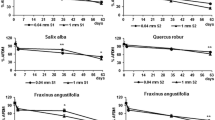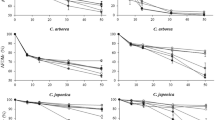Summary
A 20.5-month study was undertaken to determine detrital processing of the halophytesSpartina anglica, Elytrigia pungens, andHalimione portulacoides in three different habitats of an estuarine salt marsh in the South-West Netherlands. Decomposition was measured using litter-bags of three different mesh sizes to partition the effects of different faunal groups on decomposition. From April 1980 through October 1981 litter-bags were sampled regulary from a creek, the upper marsh, and from a plant-debris belt on the higher marsh. Dry weights and nutritive values were measured and animals were counted. Mainly rates of loss are reported here. Zonal differences were significant. At first, decomposition in the creek was most rapid. After two months the processes in the creek slowed down because of the trapping of silt by the bags, which probably simulated the natural course of the decomposition process in the water. Decomposition on the marsh followed the most regular pattern, while in the plant-debris belt the pattern was very irregular. Population dynamics of microfaunal organisms supported these findings. In the plant-debris belts loss rates seem to be higher than on the marsh, because of the influence of detritivorous macrofaunal organisms. The loss rates of the three plant species differed significantly.Halimione decomposed fastest, especially in the beginning, and in the plant-debris habitat. On the upper marsh and in the plant-debris belt the loss rates ofSpartina seem to be a little higher than those ofElytrigia.
Similar content being viewed by others
References
BRINSON, M.M., A.E. LUGO, and S. BROWN, 1981. Primary productivity, decomposition and consumer activity in freshwater wetlands. Ann. Rev. Ecol. Syst., 12: 123–161.
CRUZ, A.A. DE LA, 1980. Recent advances in our understanding of salt marsh ecology. In: Proc. Gulf of Mexico Coastal Ecosystems Workshop. Fore, P.L. and R.D. Peterson, Eds., U.S. Fish and Wildlife Service, Albuquerque, New Mexico, FWS/OBS-80/30, p. 51–65.
GOSSELINK, J.G. and C.J. KIRBY, 1974. Decomposition of salt marsh grass,Spartina alterniflora Loisel. Limnol. Oceanogr., 19:825–832.
HACKNEY, C.T. and A.A. DE LA CRUZ, 1980.In situ decomposition of roots and rhizomes of two tidal marsh plants. Ecology, 61:226–231.
HAINES, E.B., 1977. The origins of detritus in Georgia salt marsh estuaries. Oikos, 29:254–260.
HAINES, E.B. and R.B. HANSON, 1979. Experimental degradation of detritus made from the salt marsh plantsSpartina alterniflora Loisel.,Salicornia virinica L., andJuncus roemerianus Scheele. J. exp. mar. Biol. Ecol., 40:27–40.
HAINES, E.B. and C.L. MONTAGUE, 1979. Food sources of estuarine invertebrates analyzed using13C/12C ratios. Ecology, 60:48–56.
HARGRAVE, E.T., 1976. The central role of invertebrate faeces in sediment decomposition. In: The role of terrestrial and aquatic organisms in decomposition processes. Anderson, J.M. and A. McFayden, Eds., Blackwell Sc. Publ., Oxford, p. 301–321.
JOSSELYN, M.N. and A.C. MATHIESON, 1980. Seasonal influx and decomposition of autochtonous macrophyte litter in a north temperate estuary. Hydrobiologia, 71:197–208.
KRUCZYNSKI, W.L., C.B. SUBRAHMANYAM, and S.H. DRAKE, 1978. Studies on the plant community of a North Florida salt marsh. Part. II. Nutritive value and decomposition. Bull. Mar. Sci., 28:707–715.
LOPEZ, G.R., J.S. LEVINTON and L.B. SLOBODKIN, 1977. The effect of grazing by the detritivoreOrchestia grillus onSpartina litter and its associated microbial community. Oecologia, 30:111–127.
McLUSKY, D.S., 1980. Primary producers. In: The estuarine ecosystem. Blackie, Glasgow: 37–56.
NIXON, S.W., 1980. Between coastal marshes and coastal waters — a review of 20 years of speculation and research on the role of salt marshes in estuarine productivity and water chemistry. In: Estuarine and wetland processes with emphasis on modelling. Hamilton, P. and K.B. McDonald, Eds., Marine Science Vol. 11. Plenum Press, New York, p. 437–526.
ODUM, E.P., 1980. The status of three ecosystem-level hypotheses regarding salt marsh estuaries: tidal subsidy, outwelling, and detritus-based food chains. In: Estuarine perspectives. Kennedy, V.S., Ed., Academic Press, New York, p. 485–496.
POMEROY, L.R. and R.G. WIEGERT, 1981. The ecology of a salt marsh. Ecological Studies 38. Springer-Verlag, New York, 271 pp.
RANWELL, D., 1972. Ecology of salt marshes and sand dunes. Chapman and Hall, London, 258pp.
SWIFT, M.J., O.W. HEAL, and J.M. ANDERSON, 1979. Decomposition in terrestrial ecosystems. Blackwell Sci. Publ., Oxford, 372pp.
WIEGERT, R.G., 1979. Ecological processes characteristic of coastalSpartina marshes of the South-Eastern U.S.A. In: Ecological processes in coastal environments. Jefferies, R.L. and A.J. Davy, Eds., Blackwell Sci. Publ., Oxford, p. 467–490.
WOLF, L. DE and G.J.C. BUTH, 1981. A simple method for separating micro-, meio- and macrofauna, and plant litter fractions. Hydrobiol. Bull., 15:175–177.
WOLFF, W.J., M.J. VAN EENDEN and E. LAMMENS, 1979. Primary production and import of particulate organic matter on a salt marsh in The Netherlands. Neth. J. Sea Res., 13:242–255.
Author information
Authors and Affiliations
Additional information
Communication No. 233, Delta Institute for Hydrobiological Research, Yerseke, The Netherlands.
Rights and permissions
About this article
Cite this article
Buth, G.J.C., Verdonschot, P.F.M. & De Wolf, L. Decomposition of three halophytes in different habitats of an eastern scheldt salt marsh. Hydrobiological Bulletin 16, 103–112 (1982). https://doi.org/10.1007/BF02255418
Issue Date:
DOI: https://doi.org/10.1007/BF02255418




